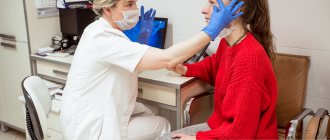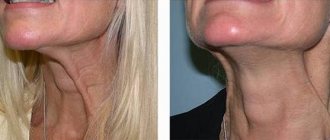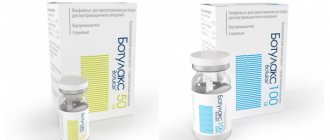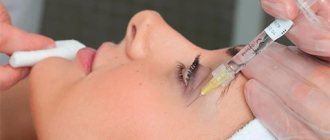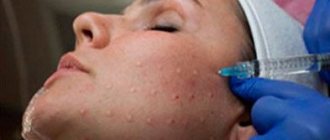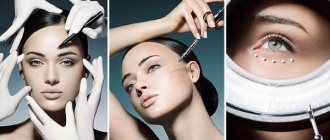Botulax refers to drugs that affect the neuromuscular system . Manufactured in South Korea to international standards and used in more than 20 countries on an ongoing basis. The drug is mainly used in cosmetology medicine to smooth out facial wrinkles and contour lips. The effect of the injections lasts for several months. Botulax in its composition is classified as an immunobiological drug, so its storage must fully comply with legally approved sanitary rules.
Composition of drugs
Both drugs contain water-soluble protein Albumin (Albuminum humanum) and sodium chloride.
Difference between Botox and Botulax:
- production technology;
- cleaning level;
- auxiliary components;
- dosage;
- price.
Let's look at each tool in more detail.
…
Botox
A classic anti-aging product with botulinum toxin, it has long been successfully used in cosmetology and medicine. Produced by the American company Allergan. World famous, well studied. The effect lasts up to 6-8 months.
Compound:
- purified class A botulinum toxin to suppress muscle impulses and relax muscles;
- Albumin is a protein for tissue repair;
- sodium chloride is a solvent for the ingredients of the drug.
Storage method: at temperatures from -3o to -17o.
…
Botulax
Manufactured by the South Korean company Hugel Inc. The effect lasts up to 4-6 months.
A relaxing antipsychotic with a good effect on facial muscles. The basis of the composition is highly concentrated protein botulinum toxin A. For stabilization, auxiliary ingredients are present. Injections are carried out slowly - foaming may occur if injected quickly.
Compound:
- Category A protein neurotoxin;
- simple water-soluble proteins in whey;
- sodium chloride 0.9%.
The prepared solution is stored for no more than a day at temperatures up to +7o.
This drug is used by specialists:
- Alexandrovich Ekaterina Olegovna
- Artamonova Olga Grigorievna
- Asmolovskaya Anastasia Viktorovna
- ASTAKHOVA ELENA VYACHESLAVOVNA
- Bychkova Natalya Yurievna
- Glozman Oksana Mikhailovna
- Gontar Alena Alekseevna
- Gorovaya Maria Olegovna
- Zharova Galina Gennadievna
- Isaeva Tatyana Viktorovna
- Karlova Olga Anatolyevna
- Kozlova Olga Valerievna
- Kolodiy Anastasia Andreevna
- Kolomiets Elena Alexandrovna
- Krasavina Diana Alexandrovna
- Kulova Zhanna Borisovna
- Kulkova Tatyana Alexandrovna
- Kusin Pavel Olegovich
- Matveeva Irina Vladislavovna
- Mishchenko Vera Sergeevna
- Moroshek Ekaterina Alexandrovna
- Mugutdinova Bahu Tazhutdinovna
- Nabieva Asiyat Magomedovna
- Novikova Yulia Vladimirovna
- Orlova Olga Ratmirovna
- Pervuninskaya Marina Alexandrovna
- Podrezova Olga Viktorovna
- Sadchikova Elena Alexandrovna
- Salamova Tamara Ovtaevna
- Safarova Vafa Vagifovna
- Semenyuk Anna Dmitrievna
- Soboleva Anna Nikolaevna
- Tishaninova Victoria Viktorovna
- Totskaya Anna Yurievna
- Chalenko Olga Anatolevna
- Chemurzieva Zaira Magometovna
- Shevchenko Elena Viktorovna
- Ekashaeva Karina Albertovna
- Yakovleva Polina Nikolaevna
- Yakupov Marat Abdullovich
Indications for use
Korean and American drugs are used in cosmetology for people aged 20 to 65 years, the target audience is 30-45 years. The effect lasts until the botulinum toxin is completely removed from the body, after which the procedure is repeated.
The drugs showed especially good results when correcting facial asymmetry, modeling oval shapes, and eyebrow lines.
For deep wrinkles and folds, self-injections will not be effective, but can be effectively used in combination with other anti-aging procedures.
Indications for Botox and Botulax injections:
- smoothing facial wrinkles;
- restoration of facial proportions, elimination of asymmetry;
- raising drooping eyelids;
- rejuvenation of the neck area;
- fight against blepharospasms;
- prevention of static wrinkles.
Which drug is more effective?
Let's compare the effectiveness of Botox and its analogue from South Korea.
Botox:
- Easily tolerated, complications are rare.
- Low effectiveness in eliminating deep wrinkles.
- The effect increases gradually from 2-3 days. Maximum result at the end of the second week.
- Frequent repeated injections form an addiction to the drug and reduce its effectiveness.
- The result lasts 6-8 months.
- Good lifting effect: the corners of the lips and brow ridges are raised.
- High price due to the popularity of the brand.
Botulax:
- Affordable price. Competitor in price even for domestic products.
- Peculiarities. The drug's production technology and components are similar to Botox.
- The duration of the effect is 4-6 months.
The general features of the drugs are targeted effects, preservation of natural facial expressions and gestures. The effect of the drugs does not extend to nearby tissues.
Description of the procedure
Stages of botulinum therapy:
- Before injections, the face is thoroughly cleansed of dirt, sebum, and makeup.
- Application of anesthetic gel to relieve pain.
- The drug is prepared in accordance with the intended dosage regimen. The required number of units is calculated depending on the segment of the face in which the injection is given.
- Administration of injections according to the scheme.
- Compress for the prevention of edema and hematomas.
- Recommendations for skin care.
The procedure takes 20-45 minutes, upon completion the client quickly returns to normal life. After 3-5 hours, visible results are already visible. All that remains is to observe the changes and follow all the specialist’s recommendations.
BOTULAX 100 UNITS 5 ml N1 lyophilisate for preparation of solution for IM administration
Special instructions:
The drug Botulax is used in specialized medical institutions. The drug is stored in a separate closed, labeled box in the refrigerator.
The unused solution of the drug remaining after the injections, as well as auxiliary instruments and materials that were in contact with the drug (syringes, needles, etc.) must be disposed of in accordance with the current rules for the destruction of biological waste.
Recommended doses and frequency of administration of Botulax should not be exceeded due to the potential risk of overdose, excessive muscle weakness, distant spread of the toxin and the formation of neutralizing antibodies.
During the initial course of treatment, it is necessary to begin with the lowest recommended dose for a specific indication for use.
Physicians and patients should be aware that side effects may occur despite previous injections being well tolerated. Care and attention must be exercised during each procedure.
Adverse effects associated with spread of the toxin from the injection site, sometimes fatal, associated in some cases with dysphagia, pneumonia and/or severe muscle weakness, have been reported. These symptoms are consistent with the mechanism of action of botulinum toxin and appear within a few hours to several weeks after injection. The risk of these side effects is greatest in patients with underlying diseases and conditions that predispose them to the development of these symptoms, including children and adults receiving high-dose treatment for spasticity.
Patients receiving the drug in therapeutic doses may also experience severe muscle weakness.
Elderly and debilitated patients should be treated with caution.
The risk-benefit ratio for a particular patient should be assessed before starting treatment with Botulax.
Dysphagia following injections in areas other than the neck muscles has been reported.
Botulax should be used with extreme caution and under close monitoring in patients with subclinical or clinical signs of impaired neuromuscular transmission, such as myasthenia gravis
or Lambert-Eaton syndrome, in patients with peripheral motor neuropathic diseases (for example, amyotrophic lateral sclerosis or motor neuropathy), as well as in patients with concomitant neurological pathology.
These patients may have increased sensitivity to this group of drugs, even at therapeutic doses, which can lead to the development of severe muscle weakness and a high risk of clinically significant systemic effects, including severe dysphagia and respiratory problems. In such cases, botulinum toxin should be used under specialist supervision and only when the benefits of treatment outweigh the risks. Patients with a history of dysphagia and aspiration should be treated with extreme caution.
Patients and caregivers should be advised to seek immediate medical attention if problems with swallowing, speech, or breathing occur.
As with any treatment that enables previously immobilized patients to return to physical activity, the patient should be counseled about the importance of reintroducing activity gradually.
Before injecting Botulax, it is necessary to clarify the anatomy of the relevant areas and any changes in the anatomy as a result of previous operations; Injections into easily damaged anatomical structures should be avoided.
Serious adverse reactions, including deaths, have been reported in patients who received Botulax for unapproved indications - injections of the drug directly into the salivary glands, oro-linguo-pharyngeal region, esophagus and stomach. Some patients had preexisting dysphagia or severe weakness.
Serious and/or immediate hypersensitivity reactions with Botulax, such as anaphylaxis, serum sickness, urticaria, soft tissue edema or dyspnea, have been reported infrequently.
Reactions have been reported both in cases of monotherapy with the drug and when used in combination with other drugs that can cause similar symptoms.
If such reactions develop, further administration of Botulax should be stopped and appropriate drug therapy, in particular epinephrine, should be started immediately.
As with any injection, complications associated with the procedure may occur. Injections may result in local infection, tenderness, inflammation, paresthesia, kinesthesia, hypersensitivity, swelling, erythema, bleeding/bruising. Injection-related pain and/or anxiety can lead to vasovagal reactions, such as syncope, hypotension, etc.
Caution must be exercised in case of weakness or atrophy of the muscles into which the drug is planned to be administered.
Rare adverse reactions from the cardiovascular system have been described, including arrhythmias and myocardial infarction, in some cases fatal. Some of these patients initially had risk factors, including cardiovascular diseases.
New or repeated epileptic seizures were observed, as a rule, in patients predisposed to these conditions. The exact connection between these phenomena and the administration of the toxin has not been established. Seizures were noted predominantly among patients with cerebral palsy.
The formation of neutralizing antibodies to botulinum toxin can reduce the effectiveness of Botulax by inactivating the biological activity of the toxin. According to clinical studies, administration of Botulax with greater frequency and in larger doses may lead to an increase in the incidence of antibody formation. Potential antibody formation can be minimized by administering the lowest effective doses with the maximum clinically acceptable intervals between injections.
Clinical fluctuations with repeated use of Botulax (as with all botulinum toxins) may result from differences in the dilution technique, the intervals between injections and the muscles injected, as well as small fluctuations in biologically determined drug activity values.
Wrinkles of the upper third of the face (glabellar wrinkles)
Infrequent blinking associated with the injection of botulinum toxin into the orbicularis oculi muscle can lead to corneal damage, persistent epithelial defects and corneal erosions, especially in patients with pathology of the VII pair of cranial nerves.
Botulax should be used with caution in the following cases:
- with pronounced facial asymmetry,
- with ptosis, dermatochalasis, deep scars,
- in patients with thick skin or in the absence of significant smoothing of vertical facial wrinkles between the eyebrows during mechanical stretching of the skin.
Rehabilitation
Unpleasant sensations are possible during the first three days: redness, swelling, bruising, soreness of the injection points, headaches. Symptoms usually go away without treatment, but if they worsen, seek medical help.
Basic recommendations for successful recovery:
- do not take a horizontal position or bend over for 6-8 hours;
- on the first day, do not touch your face, do not wash your face, do not apply makeup;
- cancel any physical activity for a week;
- do not consume spicy foods, coffee and strong tea;
- exclude visits to baths, saunas, solariums, beaches, swimming pools, water parks for 2 weeks;
- exclude the use of antibiotics, hormone-containing drugs and medications that alter blood clotting;
- give up alcoholic drinks.
A healthy lifestyle is not only beneficial for the body, but also for the injection area – it preserves botulinum toxin and, therefore, the effect of injections.
Botulax
The drug Botulax is used in specialized medical institutions. The drug is stored in a separate closed, labeled box in the refrigerator.
The unused solution of the drug remaining after the injections, as well as auxiliary instruments and materials that were in contact with the drug (syringes, needles, etc.) must be disposed of in accordance with the current rules for the destruction of biological waste.
Recommended doses and frequency of administration of Botulax should not be exceeded due to the potential risk of overdose, excessive muscle weakness, distant spread of the toxin and the formation of neutralizing antibodies.
During the initial course of treatment, it is necessary to begin with the lowest recommended dose for a specific indication for use.
Physicians and patients should be aware that side effects may occur despite previous injections being well tolerated. Care and attention must be exercised during each procedure.
Adverse effects associated with spread of the toxin from the injection site, sometimes fatal, associated in some cases with dysphagia, pneumonia and/or severe muscle weakness, have been reported. These symptoms are consistent with the mechanism of action of botulinum toxin and appear within a few hours to several weeks after injection. The risk of these side effects is greatest in patients with underlying diseases and conditions that predispose them to the development of these symptoms, including children and adults receiving high-dose treatment for spasticity.
Patients receiving the drug in therapeutic doses may also experience severe muscle weakness.
Elderly and debilitated patients should be treated with caution.
The risk-benefit ratio for a particular patient should be assessed before starting treatment with Botulax.
Dysphagia following injections in areas other than the neck muscles has been reported.
Botulax should be used with extreme caution and under constant monitoring in patients with subclinical or clinical signs of neuromuscular transmission disorders, for example with myasthenia gravis or Lambert-Eaton syndrome, in patients with peripheral motor neuropathic diseases (for example, amyotrophic lateral sclerosis or motor neuropathy) , as well as in patients with concomitant neurological pathology.
These patients may have increased sensitivity to this group of drugs, even at therapeutic doses, which can lead to the development of severe muscle weakness and a high risk of clinically significant systemic effects, including severe dysphagia and respiratory problems. In such cases, botulinum toxin should be used under specialist supervision and only when the benefits of treatment outweigh the risks. Patients with a history of dysphagia and aspiration should be treated with extreme caution.
Patients and caregivers should be advised to seek immediate medical attention if problems with swallowing, speech, or breathing occur.
As with any treatment that enables previously immobilized patients to return to physical activity, the patient should be counseled about the importance of reintroducing activity gradually.
Before injecting Botulax, it is necessary to clarify the anatomy of the relevant areas and any changes in the anatomy as a result of previous operations; Injections into easily damaged anatomical structures should be avoided.
Serious adverse reactions, including deaths, have been reported in patients who received Botulax for unapproved indications - injections of the drug directly into the salivary glands, oro-linguo-pharyngeal region, esophagus and stomach. Some patients had preexisting dysphagia or severe weakness.
Serious and/or immediate hypersensitivity reactions with Botulax, such as anaphylaxis, serum sickness, urticaria, soft tissue edema or dyspnea, have been reported infrequently.
Reactions have been reported both in cases of monotherapy with the drug and when used in combination with other drugs that can cause similar symptoms.
If such reactions develop, further administration of Botulax should be stopped and appropriate drug therapy, in particular epinephrine, should be started immediately.
As with any injection, complications associated with the procedure may occur. Injections may result in local infection, tenderness, inflammation, paresthesia, kinesthesia, hypersensitivity, swelling, erythema, bleeding/bruising. Injection-related pain and/or anxiety can lead to vasovagal reactions, such as syncope, hypotension, etc.
Caution must be exercised in case of weakness or atrophy of the muscles into which the drug is planned to be administered.
Rare adverse reactions from the cardiovascular system have been described, including arrhythmias and myocardial infarction, in some cases fatal. Some of these patients initially had risk factors, including cardiovascular diseases.
New or repeated epileptic seizures were observed, as a rule, in patients predisposed to these conditions. The exact connection between these phenomena and the administration of the toxin has not been established. Seizures were noted predominantly among patients with cerebral palsy.
The formation of neutralizing antibodies to botulinum toxin can reduce the effectiveness of Botulax by inactivating the biological activity of the toxin. According to clinical studies, administration of Botulax with greater frequency and in larger doses may lead to an increase in the incidence of antibody formation. Potential antibody formation can be minimized by administering the lowest effective doses with the maximum clinically acceptable intervals between injections.
Clinical fluctuations with repeated use of Botulax (as with all botulinum toxins) may result from differences in the dilution technique, the intervals between injections and the muscles injected, as well as small fluctuations in biologically determined drug activity values.
Wrinkles of the upper third of the face (glabellar wrinkles)
Infrequent blinking associated with the injection of botulinum toxin into the orbicularis oculi muscle can lead to corneal damage, persistent epithelial defects and corneal erosions, especially in patients with pathology of the VII pair of cranial nerves.
Botulax should be used with caution in the following cases:
- with pronounced facial asymmetry,
- with ptosis, dermatochalasis, deep scars,
- in patients with thick skin or in the absence of significant smoothing of vertical facial wrinkles between the eyebrows during mechanical stretching of the skin.
What procedures should be used to supplement botulinum therapy?
“Beauty injections” correct facial contours, make facial wrinkles less noticeable, but have almost no effect on the condition of the skin. For better results, it is worth adding a set of anti-aging procedures.
What can be combined with Botulax?
- Mesotherapy and biorevitalization - injections of cocktails based on hyaluronic acid with the addition of antioxidants and vitamins, promote the production of collagen and elastin.
- Chemical and hardware peelings will renew the surface of the skin and eliminate pigmentation.
- Fillers smooth out deep folds and create the correct relief.
After the age of fifty, combined methods work much more effectively than any monotherapy.
Contraindications
Botulax is a new drug on the Russian market and has passed the necessary studies.
Main contraindications for injections:
- individual intolerance;
- diseases: diabetes, oncology, tuberculosis, infections, endocrine and cardiovascular, chronic pathologies;
- pregnancy and breastfeeding;
- problems with blood clotting;
- menstrual period;
- hernia of the eyelids;
- chronic muscle fatigue.
The choice of anti-aging injections will be made by a cosmetologist taking into account the condition of the skin, rejuvenation area, and age. It is difficult for a non-professional to make the right decision; choosing a drug is the task of a specialist.
Botulax: smooth out wrinkles the Korean way
Expression wrinkles on the face are the main enemy of any middle-aged person who cares about his appearance. And the most effective way to combat these folds is considered to be cosmetic injections.
Botulax (BOTULAX) is a Korean analogue of Botox, a peripherally acting muscle relaxant based on botulinum toxin type A. Its manufacturer is the pharmaceutical concern Hugel Inc., and the official distributor in Russia is the Martinex group of companies. The drug passed all the necessary clinical studies in our country, and at the end of 2016 it received a registration certificate (LP-003978) and officially went on sale.
How good is this new product and is it worth giving up the time-tested and proven American Botox and French Dysport for it? What does it contain? What do practitioners say about it? Tecrussia.ru goes into detail:
↑ Composition, mechanism of action and main indications
Botulax is available in the form of a lyophilisate for the preparation of injections in glass bottles of 50 and 100 units of toxin. The plant in Korea also produces bottles of 200 and 150 units, but they are not supplied to Russia. All active components in the composition, their quantity and characteristics are completely similar to Botox:
| Comparison criterion | Botulax 100 units | Botox 100 units |
| Molecular weight of botulinum toxin molecules | 900 kDa | 900 kDa |
| Albumin (stabilizing protein) | 500 mcg | 500 mcg |
| Sodium chloride | 900 mcg | 900 mcg |
The drug works as follows: when botulinum toxin type A enters muscle fibers, it blocks the transmission of nerve impulses through them. This causes temporary paralysis and relaxation of the target muscles, causing the surrounding skin to visibly smooth out. Botulax injections are performed to correct the following defects:
- facial wrinkles on the forehead, between the eyebrows, around the eyes and mouth, in the nasolabial triangle;
- blepharospasms;
- facial asymmetry caused by muscle spasms;
- wrinkles on the neck caused by increased muscle tone;
- lip contour correction;
- treatment of hyperhidrosis (excessive sweating) of the armpits, palms, and feet.
The decrease in muscle activity begins within 3-4 hours after the injections, and the total duration of the effect declared by the manufacturer reaches 4-6 months (the exact period depends on the metabolic rate in the body, the individual reaction to the drug, the presence of an “addictive effect” in the patient, etc.). P.)
↑ How the procedure is performed
Preparation for injections begins 3-4 days before the session with a cosmetologist. During this period, you need to stop taking antibiotics, drugs that affect blood clotting, stop smoking, drinking alcohol, and visiting the bathhouse or sauna.
- The first step is to cleanse the skin of the selected area from makeup residues and impurities. Then an antiseptic and a local anesthetic are applied. If necessary, markings are made.
- For the numbing cream to work, you need to wait about 15-20 minutes. At this time, in the presence of the patient, the cosmetologist takes out and unseals the packaging, syringes and prepares the solution for injection.
- 1 unit of Botulax is considered equal to 1 unit of Botox. Dilution schemes and standard injection points are also completely similar.
- Administration of the drug takes 10-30 minutes, depending on the size and number of treated areas. Upon completion of the injections, an antiseptic is again applied to the face, after which the patient can immediately go home.
The first noticeable changes appear within 3 hours after the procedure, and over the next 3-4 days the effect will gradually increase. The final result can be assessed in about 2 weeks. If the drug does not give the desired result, additional correction can be made in a small volume during the same period. The resulting effect lasts for 4-6 months, after which a new injection session will be needed.
↑ Contraindications, complications, possible side effects
The restrictions on the use of Botulax are the same as for other drugs based on botulinum toxin type A:
- hypersensitivity to the components of the composition;
- pregnancy and lactation;
- inflammatory processes on the skin in the target area;
- bleeding disorders;
- herpes, as well as any infectious and chronic systemic diseases in the acute stage;
- feverish condition;
- diabetes;
- oncological diseases;
- pronounced hernial protrusions on the lower and upper eyelids;
- myasthenia gravis (Myasthenia Gravis) is an autoimmune disease that causes chronic muscle fatigue syndrome;
- age under 18 and after 65 years.
| Photo 1 – results of correction of crow’s feet with Botulax: | |
The main complications and side effects that patients may encounter after injections of “Korean Botox”:
- Drooping of the upper eyelid is usually a consequence of a cosmetologist’s mistake (incorrect dosage of the drug, incorrect injection points, etc.) Depending on the treatment area, eyebrows and corners of the lips may also be affected. This type of ptosis usually lasts 2-3 weeks and goes away on its own.
- Individual reactions to the introduction of a toxin into the body. Possible in the first 1-2 days after the procedure. They can range from harmless – such as dry mouth and mild muscle tremors – to extremely unpleasant: nausea and vomiting, fever, dizziness, etc.
- Swelling of the eyes and upper eyelids - most often this is simply a reaction of the skin to injections, which quickly disappears. In more serious cases, lymphedema occurs, which lasts up to several months and requires additional medical attention.
- Standard problems associated with injections of any type: hematomas and redness at injection sites, infection, etc.
- See also the article “Complications after Botox”.
To avoid unwanted “side effects”, in most cases it is enough just to take the post-procedure recommendations of the cosmetologist responsibly. So, for several days after the injections, you cannot actively work with the facial muscles, rub or massage the treated areas. It is undesirable to take a lying position (while sleeping, you should place a second pillow under your head). For 1-2 weeks you will have to give up visiting the gym, solarium, bathhouse/sauna, as well as drinking alcohol and smoking.
↑ How much does Botulax cost? Current prices
Since this drug appeared on the Russian market relatively recently, it is too early to talk about the average cost of procedures using it. As a guide, you can take the prices of official sellers:
- the price of 1 package of Botulax for 100 units is 6800 - 8000 rubles;
- packaging for 50 units will cost 4000 - 5500 rubles,
- this is approximately 1.5-2 times cheaper than the cost of a similar volume of Botox. Accordingly, we can expect that the “procedural” cost of 1 unit. in Moscow will be about 300-350 rubles.
Thus, the Korean drug will cost significantly less than its American competitor. The only question is whether the quality and the result are comparable.
↑ Pros and cons: how Botulax differs from other drugs based on botulinum toxin
In Russia, neither large clinics nor popular cosmetologists with a large flow of patients have yet adopted the new product - however, on specialized forums you can already find many reviews from Ukrainian specialists (the drug has been actively used here for several years) and their Russian colleagues who have purchased it abroad. Analyzing these opinions, it can be assumed that, unlike its analogues, Botulax is characterized by:
- Severe headaches, sometimes persisting for 4-5 days after injections.
- A fairly high percentage of the drug “fails to work” - the effect of the injection is minimal or does not occur at all.
- Accelerated resorption period - instead of the standard six months, the changes last only 2-3 months.
However, there are also diametrically opposed opinions:
- Cosmetologists and their patients, for whom Botulax worked according to all standards, are completely satisfied with both the effect and its duration.
- Some experts note that the result is very natural - the drug smoothes out facial wrinkles without affecting neighboring muscles and thereby not “freezing” facial expressions.
| Photo 2 – wrinkles on the forehead before and after the procedure: | |
↑ Conclusions TecRussia.ru
- There is not yet enough information and reviews to evaluate the properties and effectiveness of Botulax in comparison with other botulinum toxins. Cosmetologists express both positive and negative opinions on it. However, the latter may be associated with incorrect dosage selection and other technical errors by doctors who did not undergo appropriate training and/or used a counterfeit product. None of the specialists whom we completely trust are working with him yet.
- The obvious advantages of the drug are the presence of official registration in the Russian Federation, a transparent supply chain, the reputation of Martinex (one of the largest companies in the industry), as well as a relatively low price. We do not see any significant shortcomings, except for the fact that there are very few reports on its practical use.
- We recommend trying it for those who would like to save on the cost of the procedure and are ready for reasonable experiments for this purpose. More conservative patients who are willing to pay more for a completely predictable and stable effect are better off choosing well-known and proven brands such as Botox or Dysport.

